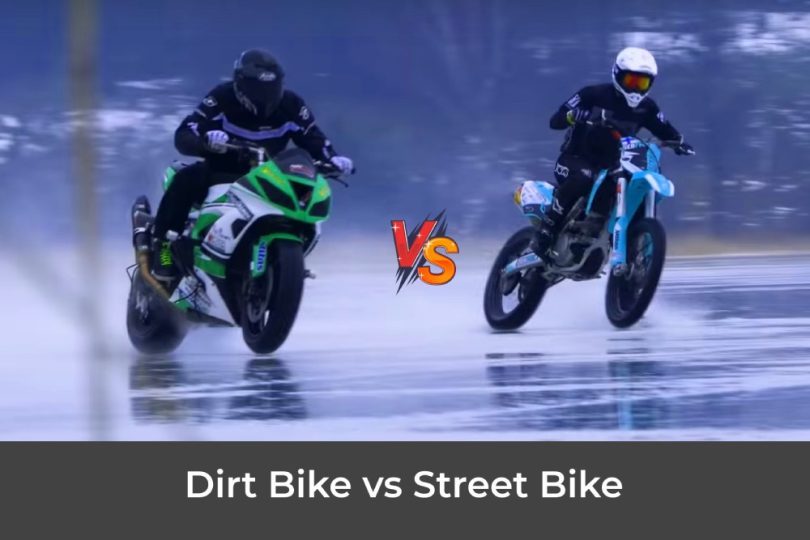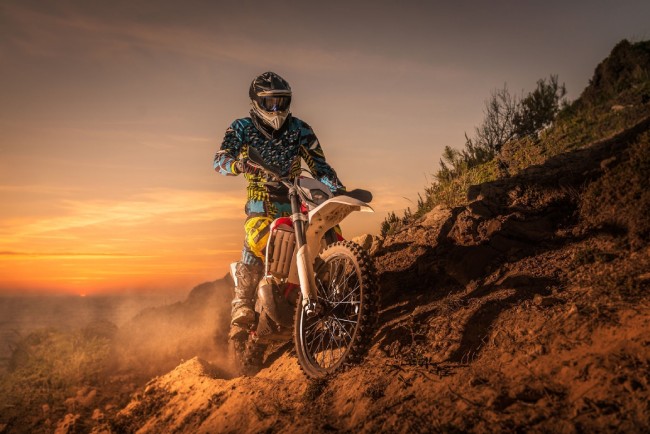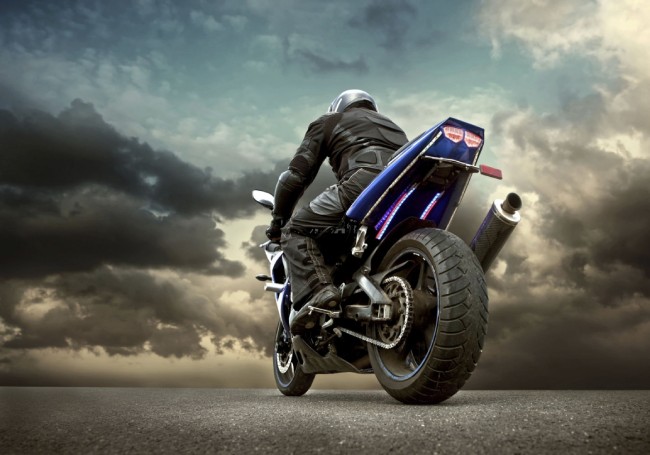In terms of safety, the main difference between dirt and street riding can be summed up this way –
Street means serious injuries but less often while dirt means minor injuries but more often.
If you think dirt biking is safer because there’s no traffic or 4-way intersections, think again! Most enduro and dirt riders we personally know have broken their bones at least once.
What about control?
Using the clutch and shifting are the same but you need to learn how to shift gears without using the clutch since that’s what you’ll mainly be doing with your dirt bike.
The biggest challenge is getting used to the lack of traction on dirt and letting the bike move around beneath you. You need to trust your bike and use the front brake.
Also, many street bikers are too rigid on their dirt bikes. Move back and forth on the bike and spend most of your time standing up. Use your legs to grip the bike, not your arms; and use your knees to help absorb bumps.
Let’s see if you can finally switch to trail bikes if you’ve been riding only street bikes all these years!
Transitioning From Street to Dirt Riding
Get prepared to encounter too many small accidents. But don’t worry, the slower speed and the lighter bike means minimum damage to your body and your bike.
As said before, traction is what will matter most that you will have to get used to. Let the bike slide and move beneath you.
You may feel too slow when riding dirt bikes even at higher speeds and the brakes may not seem powerful when used.
Unlike street bikes, don’t focus too much on the seat because you will be standing frequently to handle the bike better when facing obstacles and unpaved roads.
You will surely like the experience because there is no traffic on the way or speed limit. You will also be able to jump over obstacles and get closer to nature visiting places that a street biker can’t even think about.
The only annoying thing is you will find your bike out of fuel more frequently since it will have a smaller fuel tank. Also, the stability of the bike will feel less as it is lightweight. You may not find eye-catching designs as well.
Going From Dirt Bikes to Street Bikes
There is no doubt that a dirt rider can be a better street bike rider than a beginner. So, you don’t need to worry much as many of your skills will be translated directly except for bike handling and power delivery.
The main differences you will notice are in safety and the riding experience. As the roads are even and have fewer obstacles, you will face fewer accidents on street biking. But if you face any, then it may bring immense damage to both you and your bike because of the higher speeds.
You will surely feel the difference when cornering too. You are used to keeping your body as straight as possible while cornering with a dirt bike. But your body needs to be leaned more in the case of street biking.
The funny thing is that you may find yourself sticking a leg out automatically while turning as you are used to doing it while dirt biking.
You may also face problems with your sitting position as both have different sitting positions. Your body will tell your bottom to keep it forward while you don’t really need to do this with street motorbikes.
What’s more, you’ll love bumpy roads because you know how to handle sand, mud, snow, and ice with confidence. Even if the traction is lost during cornering, accelerating, or braking, you will be able to tackle the situations very well.
Another important thing to remember is your tires need to be warmed up to take corners effectively.
Remember not to ride crossed up so you can avoid high-side crashes as the speed will be higher, the bike weight and inertia will be more, and the pavement will be harder.
Unlike dirt roads, you will surely face a lot of traffic. You need to get some experience in road awareness and how to drive through traffic. If you have car driving experience, then the rules are the same but you just need to be more defensive on the street while on a bike.
Dirt Bike vs Street Bike: How Do They Differ?
| Comparing factors | Dirt bike | Street bike |
| Weight | Lighter | Heavier |
| Size | Smaller | Bigger |
| Tires | Narrower | Wider |
| Frames | Mostly plastic made | Metal made |
| Tanks | Smaller | Bigger |
| Steering | More wide | Less wide |
| Suspensions | Mostly have hydraulic tubes and spring shocks | Generally have tighter shocking system |
| Brakes | Less powerful | More powerful |
| Stability | Less | More |
| Safety | Smaller injuries, more often | Bigger injuries, less often |
| Highest Speed | Low | High |
| Style | Less stylish | More stylish |
Weight
Dirt bike:
Dirt bikes are generally nimbler than street bikes since they need to make quick turns and be handled easily. They usually come with a single cylinder and a smaller displacement to reduce weight.
Street bike:
Street bikes have larger engines to keep up with the traffic and more body components to be different from competitors, which also adds extra pounds to their weight. However, the extra weight ensures better stability.
Size
Dirt bike:
As the dirt biker needs to have better control of the bike, these bikes are smaller and come with minimum components to stay on the light side.
Street bike:
Street bikes need more weight to be more stable and overcome the drag of bigger vehicles on the road. That is why they tend to be bigger.
Tires
Dirt bike:
Since off-road tires need better traction on dirt or gravel surfaces, they have extra knobs with large empty spaces and big blocks so the tire can claw in mud, dirt, and sand. These tires also have flexible carcasses and narrower designs.
Street bike:
The tires of street bikes are wider, smoother and rounder for a better grip on the surface and more rubber contact on the road. There is also less space in the knobs for the same reason.
Frames
Dirt bike:
Dirt bike frames are generally made of hard plastic that makes them lighter and less rigid than their metal-made counterparts. Their smaller size and flexible frames also make these bikes easier to handle.
Street bike:
To gain more stability and rigidity, street bike frames are usually metal-made. A metal frame also can provide eye catchy designs, which you will also look for when it’s time to choose.
Seats
Dirt bike:
You may have noticed that competitive dirt bikers are often standing when they maneuver across hurdles. For this reason, dirt bike seats are leaned forward to ensure quick and efficient adjustment.
Street bike:
Although street bike seats have different positions and functions, they generally sit further back to provide a more relaxing position for long rides.
Tanks
Dirt bike:
Dirt bikes have smaller tanks as they are not designed for venturing far away. Moreover, a bigger tank weighs more, which goes against the purpose of making lightweight bikes.
Street bike:
As you can take long rides with street bikes, the more fuel support they have the further you can go. So, it’s obvious that street bikes have larger tanks.
Steering
Dirt bike:
On dirt bikes, you mostly need to depend on bars when dealing with the ruts. So the bars are wider on dirt bikes to have more leverage and the capability to take the tire much further when turning them from one side to another.
Street bike:
Street bikes don’t need much steering as just leaning on the sides in your direction is enough to take turns in corners. You may only need larger steering input to steer through traffic or at parking lots.
Clutch
Dirt bike:
You will likely stay in the same gear and increase the revs using the clutch just like other dirt riders. So, you will need the clutch more on a dirt bike.
Maintaining the throttle constantly and applying the clutch to control the wheel drive is much easier than controlling the speed by the throttle and moving through the gears.
Street bike:
You do not usually need to slip the clutch when riding street bikes as they are geared for effortless moving at freeway speeds. You may only need the clutch when blipping the throttle to downshift and disengage it for a fraction of a second when you upshift.
Safety
Dirt bike:
Motorcycles are more prone to accidents as they also need to be balanced along with other driving aspects.
Although it depends on the ability, expertise, and experience of the rider, dirt bikes are more likely to get in accidents since there are more obstacles along the way.
Street bike:
Street bikes are heavy and move at higher speeds. This means the probability of a serious accident.
It’s true that there are minimum obstacles on streets but you have to count the number of traffic and intersections on the road too.
Suspension
Dirt bike:
Dirt bikes have better suspension systems than street bikes as the surface won’t be smooth. Systems like spring shock and hydraulic tubes are used in dirt bikes to absorb as much shock as possible.
Street bike:
Bikes don’t need many suspensions as the paved road is mostly even. Too much suspension may cause discomfort because of the bouncy rides. Excessive bounce may also bottom you out from your bike in the middle of the road.
Brakes
Dirt bike:
Dirt bikes usually come with smaller brake rotors while some may only have a single disk up front. But you can use the rear brake more often on a dirt road,
Street bike:
The power of these bikes increases along with their speed and weight. The more power the bikes have the more powerful the braking system will be.
Street bikes are usually heavier and run at higher speeds. So, they have more powerful braking systems than dirt bikes.
Gears
Both bikes have similar lower gears but the only difference is in the final gear of a dirt bike (if it is a street-legal bike). It is slightly different to give you highway cruising ability.
Advantages and Disadvantages of the Dirt Bike
Pros:
- Better performance on dirt biking
- Lightweight
- Smaller in size
- Extra knob
- Better steering
- powerful suspension
- Wider handlebars
Cons:
- Less powerful brakes
- Less safe
- Less stable
Advantages and Disadvantages of the Street Bike
Pros:
- Better performance on road
- More stable
- Bigger tank
- Stylish
- More powerful brakes
- More safe
Cons:
- Heavyweight
- Bigger in size
- Smaller handlebars
FAQs
1. What is a street legal dirt bike?
Ans: Normally you can not ride a dirt bike on the street, it’s illegal. But there is a solution for that, and that is a street-legal dirt bike. They are dirt bikes but you can ride them on the street as they are registered and plated.
In the motorcycle industry, they are also known as dual sport bikes as they come with road tires and can be ridden on both dirt roads and streets.
Street-legal dirt bikes are easier to turn for their special steering geometry. That’s why they are easier to ride than street bikes at lower speeds. Their riding position is also more relaxing.
2. How fast can a dirt bike go?
Ans: Although the speed of a bike depends on different factors like the type of engine, terrain, and horsepower, the average speed of a dirt bike is 50 to 60 miles/hour.
3. How old do I have to be to ride a dirt bike?
Ans: There is no age limit for dirt riding according to dirt riders, so if your kid can ride a bicycle smoothly, he can also try a dirt bike as there are small electric dirt bikes for even three years old kids.
4. Are dirt bikes automatic?
Ans: No, not all dirt bikes are automatic but there are some, which are automatic and easier to handle as you don’t need to worry about doing something wrong or hurting others.
Bike’s automatic transmission is not like a car’s one as they have manual clutches and gears that need to be upshifted or downshifted.
5. What’s the highest CC dirt bike?
Ans: The MAICO 700 2-stroke is the highest cc dirt bike until now. It is made by Frank White of ATK who developed it with a massive 2-stroke engine that is as powerful as a car engine. It has a 685cc engine that gives 82 horsepower.
6. What does the F mean on a dirt bike?
Ans: Adding the letter F means that the bike has a four-stroke engine instead of a two-stroke, eg; a 250SX-F vs a 250SX or a CRF250R vs a CR250R.
7. What’s the fastest motorcycle?
Ans: The Kawasaki Ninja H2R is the fastest bike until now as it can reach 0 to 100 km/h in just 2.5 seconds.









